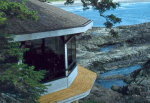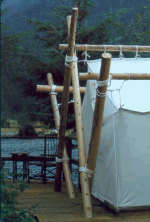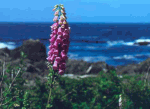written and photographed by Mary L. Peachin
Feb 2001, Vol. 5 No. 4
 Daily life in Tofino revolves around the flood and ebb of the ocean tide. The fourteen-foot differential between the high and low Pacific tide affects not just beach lovers, but anglers, kayakers, scuba divers, surfers, and whale watchers as well. Folks begin their day by looking at the tidal charts just as some of us might check the weather forecast. Black bears and bald eagles time their feeding habits to scavenge the beach at low tide.
Daily life in Tofino revolves around the flood and ebb of the ocean tide. The fourteen-foot differential between the high and low Pacific tide affects not just beach lovers, but anglers, kayakers, scuba divers, surfers, and whale watchers as well. Folks begin their day by looking at the tidal charts just as some of us might check the weather forecast. Black bears and bald eagles time their feeding habits to scavenge the beach at low tide.
Tofino sits on a promontory virtually at the end of road. Highway 4, a two-lane highway winds through Pacific Rim National Park Reserve to this picturesque village on the west coast of Vancouver Island. Historically a fishing port, Tofino has in recent years become a tourist destination because of its isolation and remoteness and the rugged beauty of its volcanic coastline.
 Most watersport activities center on the Clayoquot Sound harbour. Adventure companies, luring clients with bright red “survival” suits hung on doorframes, offer kayaking, whale watching, and salmon fishing. There are quaint shops, and the local crowd hangs out at the bakery.
Most watersport activities center on the Clayoquot Sound harbour. Adventure companies, luring clients with bright red “survival” suits hung on doorframes, offer kayaking, whale watching, and salmon fishing. There are quaint shops, and the local crowd hangs out at the bakery.
Kayakers launch into Clayoquot Sound near the float plane dock, while visitors going whale watching stand out by the brightness of the red suits. Other options include a trip to a Hot Springs Cove, bear watching, or exploring a native village. A kite and bike shop sells new kites and rents old mountain bikes. There is also a new Budget car rental in town.
 Bed and breakfasts abound and many seafood restaurants have views of the harbour and sound. There are also a number of beach resorts and motels, the ocean view lodge cabins of Middle Beach resort, and the luxurious Wickinnish Inn.
Bed and breakfasts abound and many seafood restaurants have views of the harbour and sound. There are also a number of beach resorts and motels, the ocean view lodge cabins of Middle Beach resort, and the luxurious Wickinnish Inn.
Locals simply called it “the Wick.” Every room offers an ocean view and guests drift into slumber to the sound of crashing waves. The circular Pointe restaurant cantilevers above craggy volcanic rocks. General manager, Charles McDiarmid, has managed to sell visitors on coming to Tofino during winter months to watch violent winter storms pound twenty-foot waves, spraying the floor to ceiling glass windows of the restaurant. The sound of crashing waves is piped into the restaurant and blended with classical music like Vivaldi’s concerto of Winter.
 Ever so gently, Clayoquot Wilderness’ floating resort swings with the incoming tide. The movement is indiscernible to most, until the spectacular view fixates your eyes on the dense forest growth of the Catface or Bedingfield mountain ranges lining the perimeter of Quait Bay. It is then that you realize that the movement of the boat allows you to scan the horizon.
Ever so gently, Clayoquot Wilderness’ floating resort swings with the incoming tide. The movement is indiscernible to most, until the spectacular view fixates your eyes on the dense forest growth of the Catface or Bedingfield mountain ranges lining the perimeter of Quait Bay. It is then that you realize that the movement of the boat allows you to scan the horizon.
Nine miles by boat from Tofino, but timelessly away from civilization, Clayoquot Wilderness Resort is moored in the northeast corner of a sheltered cove. The luxurious barge, colorful with hanging flower baskets along the deck, is isolated and hidden by a narrow channel from Cypress Bay. Depending on the tidal chart, manager John Caton, advises guests on selecting the next day’s activity.
 Deep in the heart of the British Columbia rainforest on Flores Island, an 11-kilometer trail is hidden. Hikers are transported by boat from the Tofino harbour to Cow Bay, site number ten, named for an old Trapline T0108T449, once owned by an Ahousaht First Nations trapper named Noah Thomas. As local Qaamina Sam, says, “the 8-mile trail is like walking a million steps.” Opened in 1996, the Ahousaht built a mile of cedar plank boardwalk along the boggy parts of the rainforest. The trail is interspersed with white sandy beaches. At low tide, some of the beaches connect allowing a detour from the forested trail.
Deep in the heart of the British Columbia rainforest on Flores Island, an 11-kilometer trail is hidden. Hikers are transported by boat from the Tofino harbour to Cow Bay, site number ten, named for an old Trapline T0108T449, once owned by an Ahousaht First Nations trapper named Noah Thomas. As local Qaamina Sam, says, “the 8-mile trail is like walking a million steps.” Opened in 1996, the Ahousaht built a mile of cedar plank boardwalk along the boggy parts of the rainforest. The trail is interspersed with white sandy beaches. At low tide, some of the beaches connect allowing a detour from the forested trail.
 Down in Ucluelet, about 25-miles south of Tofino, there is the recently opened Wild Pacific Trail. The two kilometers groomed trail has many viewpoints of the rugged coastline. Hikers can sit on cedar benches and picnic while watching the bays and coves along the Pacific.
Down in Ucluelet, about 25-miles south of Tofino, there is the recently opened Wild Pacific Trail. The two kilometers groomed trail has many viewpoints of the rugged coastline. Hikers can sit on cedar benches and picnic while watching the bays and coves along the Pacific.
Black bears share the beaches with eagles during low tide. They feed on crustaceans caught in the seaweed left on the beach. In the fall when the salmon head upriver to spawn, the bears will turn their attention to some salmon fishing.
 Anglers time their fishing around the slack hours of the flood (incoming high) and ebb of the tide. Mooching or trolling slowly for salmon on downriggers seems to be most effective during these hours. The tide brings the bait that the salmon feed on.
Anglers time their fishing around the slack hours of the flood (incoming high) and ebb of the tide. Mooching or trolling slowly for salmon on downriggers seems to be most effective during these hours. The tide brings the bait that the salmon feed on.
The “J” and “D” pod of Orca killer whales also feed on the bait, They roll, breech, and “sky hop” forming circles around the bait to the delight of whale watchers. Resident grey and occasional humpbacks can also be sighted.
 Back at the beach, folks can dig for clams or search for oysters and sea urchins in tidal pools left by the outgoing tide. Kids might just want to look at the brightly colored starfish and anemones.
Back at the beach, folks can dig for clams or search for oysters and sea urchins in tidal pools left by the outgoing tide. Kids might just want to look at the brightly colored starfish and anemones.
When the tide is low, Jim Martin, tends to his flats of oysters. Famous for his oversized Jim’s roasting oysters, low tide can sometimes come during the middle of the night. These scrumptious oysters, about 100,000 a year are harvested, require five years before their shell is filled to Jim’s satisfaction. They are served in fine restaurants in Tofino and Ucluelet.
The border of Pacific Rim National Park Reserve ends a few miles before reaching Tofino. The Reserve, was created in 1970 as Canada’s first national park on the Pacific coast, encompasses the west coast of British Columbia including most of Vancouver Island, the mainland coast, the coastal mountains, and the Queen Charlotte Islands. There are campsites along Pacific Rim and Long Beach is a popular place for surfing, particularly during the high surf of the winter.
 The uniqueness of Tofino was aptly said by Courtney Caton, the son of Clayoquot Wilderness Lodge manager, “the water level is never the same so you are always seeing something new and different.”
The uniqueness of Tofino was aptly said by Courtney Caton, the son of Clayoquot Wilderness Lodge manager, “the water level is never the same so you are always seeing something new and different.”
If you go:
Car travel requires a BC Ferry to either Victoria (a 5 hour drive) or Nanaimo(3 hours), then driving across Vancouver Island on a winding mountain highway through the city of Alberni. Daily air service offered by North Vancouver Air is recommended only for non-white knuckle flyers. The aircraft is a Piper Navajo 10-seater. The landing strip, located at the golf course, has no terminal. Budget Car Rental opened the summer of 2000.
Wickaninnish Inn & Pointe Restaurant (800) 333-4604 or email wick@wickinn.com or www.wickinn.com
Clayoquot Wilderness Resort: 1-888-333-5405 or www.wildretreat.com
Middle Beach Lodge 250-725-2900 or e-mail mblodge@island.net or www.middlebeach.com
Budget Car Rental 1-250-725-2060
Tofino Air 1-250-725-4454
BC Ferries 1-888-BCFERRY (1-888-223-3779) or www.bcferries.com
“Where to Dine and Stay in British Columbia” info@ulysses.ca www.ulyssesguides.com
